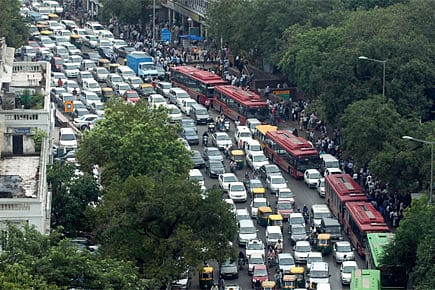Dark Nights (and Days)

A Centre powerless in every way can do nothing to stop states from overdrawing electricity
NEW DELHI ~ For a country with superpower delusions, the super power cuts of 30-31 July should serve as a wake-up call. Over the course of those two days, more than two-thirds of the country was affected and left completely without power for hours at a stretch after three of India's five power grids in all—northern, eastern and north-eastern—collapsed.
And this happened at a time when a third of the country's population does not even have access to electric power supply, and barely nine out of 30 states have achieved complete if basic electrification so far. At 734 units, the per capita consumption of power in India is among the lowest in the world, against an average of nearly 2,500 units.
There are so many Indians who do not even fall under the category of electricity consumers because their other basic needs—two square meals a day, clean drinking water and sanitation—are yet to be met. Imagine what the power supply scenario would be when everyone has the option of using electricity. With an above-average rate of economic expansion, energy-inefficient townships and housing complexes springing up in metro cities as well as areas beyond B-towns, and with so many Indians yet to be brought within the ambit of better living conditions, demand is only expected to grow rapidly. In such a scenario, things can only go from bad to worse, as the largely state-run power sector appears unprepared even for the present, let alone the future.
2025 In Review
12 Dec 2025 - Vol 04 | Issue 51
Words and scenes in retrospect
This statement by the chairman of the state-run Power Grid Corporation, RN Naik, on Tuesday, is telling: "Even before we could figure out the reason for yesterday's failure, we had more grid failures today." The outgoing power minister, who now heads the Home Ministry, Sushil Kumar Shinde, chose to blame the states. "I appeal to states to stick to [their] allocated quota. I have told officers to fine states that take more power than allocated. Our ministry kept notifying those states that were extracting extra power. States taking more power than they should have become a problem again for the nation," he said.
The two statements to the media, made by two different people at the apex of India's power and energy management apparatus, underline a problem bigger than a serial grid collapse: the apparatus has been created such that it is powerless against errant states. Poor planning has been compounded by indiscipline by the states, and the helplessness of the ministry and power regulators. Along with Punjab, Haryana, Jammu & Kashmir and Uttarakhand, Uttar Pradesh has been overdrawing power, which led to the grid collapses on two consecutive week days. The Central Electricity Regulation Commission (CERC) has reportedly issued notices to the officials concerned in these governments, asking them to appear before it next fortnight and explain why they continued to overdraw power despite warnings by the ministry.
Uttar Pradesh, Punjab and Haryana have been overdrawing power since 1 January 2012. Haryana and Punjab are states where vote bank politics has played havoc with power supply for decades now. The current Punjab Chief Minister, Parkash Singh Badal, who is at the helm of affairs in the state for the fifth time, introduced the unsustainable sop of free power to farmers in an earlier regime. This bleeds the state financially as well as causes long power cuts nearly every day. The regional load dispatch centres that monitor the country's five regional power grids can only warn states to not draw excessive power, but they can neither cut supplies if a state overdraws power, nor penalise the defaulting state.
India produces approximately 1,70,000 MW of electricity, leaving us short of demand by 7 to 10 per cent at any given point in time. Nearly two-thirds of this power is generated from thermal and traditional sources. About one-fifth comes from hydro power projects. Capacity addition and the availability of fuel are already areas that are in the red. Extraordinarily inefficient transmission and distribution make matters worse. Transmission and distribution (T&D) losses in India vary from state to state, from a little under 25 per cent to nearly 60 per cent in the worst case scenario. In 2010, India's T&D losses stood at more than 30 per cent. In the US and China, these were under 7 per cent.
It doesn't take rocket science to conclude that by improving the T&D of power supply, a huge gap can be plugged. With stringent measures to control overdrawing by states, at least the country's energy needs in the present and near future can be met.
